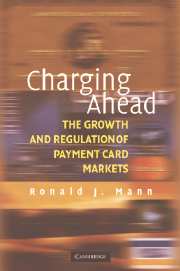Book contents
- Frontmatter
- Contents
- Figures and Tables
- Acknowledgments
- Introduction
- PART I THE BASICS OF PAYMENT CARDS
- PART II EASY MONEY
- PART III THE PUZZLE OF PAYMENT CARDS
- 6 Explaining the Pattern of Global Card Use
- 7 The Introduction of the Payment Card
- 8 Revolving Credit
- 9 Point-of-Sale Debit
- 10 Convergence and Exceptionalism in the Use of Cards
- PART IV REFORMING PAYMENT SYSTEMS
- PART V OPTIMIZING CONSUMER CREDIT MARKETS AND BANKRUPTCY POLICY
- Conclusion
- Appendix: Country-Level Data
- Notes
- Bibliography
- Index
6 - Explaining the Pattern of Global Card Use
Published online by Cambridge University Press: 06 July 2010
- Frontmatter
- Contents
- Figures and Tables
- Acknowledgments
- Introduction
- PART I THE BASICS OF PAYMENT CARDS
- PART II EASY MONEY
- PART III THE PUZZLE OF PAYMENT CARDS
- 6 Explaining the Pattern of Global Card Use
- 7 The Introduction of the Payment Card
- 8 Revolving Credit
- 9 Point-of-Sale Debit
- 10 Convergence and Exceptionalism in the Use of Cards
- PART IV REFORMING PAYMENT SYSTEMS
- PART V OPTIMIZING CONSUMER CREDIT MARKETS AND BANKRUPTCY POLICY
- Conclusion
- Appendix: Country-Level Data
- Notes
- Bibliography
- Index
Summary
If you just looked at the plastic cards presented at retail counters, you might conclude that the credit card has spread throughout the developed world as uniformly as the products of Walt Disney and McDonald's. In fact, however, the credit card as used in the United States has no close parallel in any other country. Outside the United States, the card normally is used for far fewer transactions, with a much smaller share of borrowing. The story of how cards have come to be used so differently occupies the next five chapters of this book.
Variations in the Pattern of Usage
Even the casual tourist would expect the use of credit and debit cards to differ somewhat from country to country, if only because developed economies must use cards more than undeveloped economies. In fact, however, the pattern of usage is much more complex. Currently, among large and developed economies, card use differs substantially on almost any criterion one might care to offer.
Figure 6.1 shows the rate of card usage. The rate of card transactions per capita varies from low-use countries like Japan (with less than twenty transactions per person per year), to moderate-use countries like Australia and the United Kingdom (about seventy transactions per person per year), to high-use countries like Canada and the United States (about 115 transactions per person per year).
- Type
- Chapter
- Information
- Charging AheadThe Growth and Regulation of Payment Card Markets around the World, pp. 75 - 80Publisher: Cambridge University PressPrint publication year: 2006

